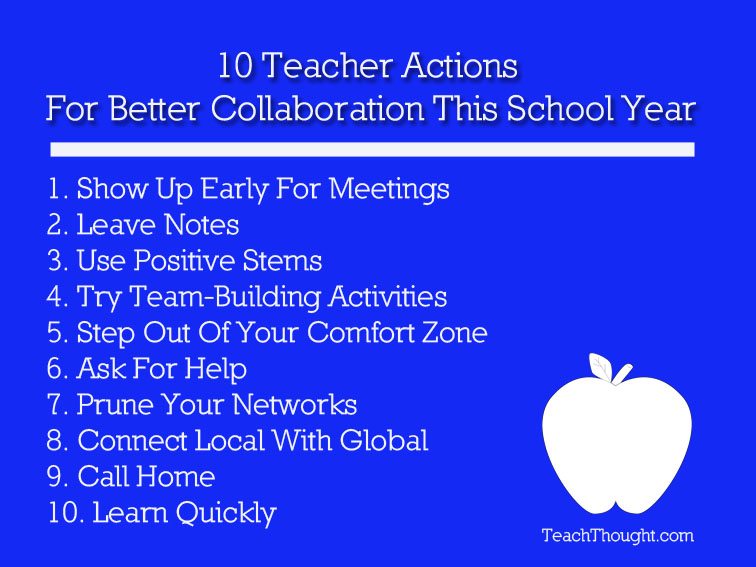From The Classroom To Your PLN: 10 Collaboration Tips For 21st Century Teachers
by Terry Heick
Summer is a make-it-or-break-it time for educators.
The non-stop, brutal schedule that is a school year starts with all the finesse of trampling elephants, and doesn’t relent for the next nine months (not coincidentally, the same amount of time it takes to gestate a baby). That makes starting the year right important — and there are few more critical pieces to an educator’s success than collaboration.
Collaborating In the Classroom
1) Call Home
Yes, having a blog is great, and you’re ahead of the curve if you use Edmodo, Facebook, Schoology or any other of a number of platforms built to help educators and families connect. But as busy as you — and the parents of your students — are, the more personal the initial communication, the better.
If you can make five phone calls each day before heading home, you should be able to reach out with a positive message to each parent by the end of the first month of school. An alternative is hand-written postcards, but phone calls — or better yet, face-to-face meetings — are ideal.
2) Use Team-Building Activities
Team-building activities are excellent ways to get the year started right by connecting with students. So many students believe that they’re starting off the year at a major deficit. Success — or mere participation — in an early team-building activity can change that.
3) Learn Quickly
This one seems obvious, but it can be huge challenge for some teachers (don’t ask me how I know). Do whatever it takes to learn the names of your students quickly. Use your district’s grade and attendance software if it provides student images from the year before. Developing five-minute games to start each class will help speed the process. Use assigned seats or nametags.
Whatever you do, learn those names, and do so quickly. Nothing de-authenticates a relationship quicker than, “I really care about your learning Mr. — wait, what’s your name again?”
Collaborating In Your Building & District
4) Step Out of Your Comfort Zone
We all have comfort zones, some more confined than others. You need not live beyond your comfort all the time, but don’t be afraid to step outside your normal stomping grounds to make new friends, or at least show yourself to be accessible, curious and ultimately collaborative even if you’re not a social butterfly.
5) Show Up Early to Meetings
Oftentimes, more collaboration happens in the five minutes before a meeting than in the meeting itself. Showing up early isn’t always easy, but if you’re going to try, better June or July than March. And during meetings, try building off your colleagues’ ideas in PLCs, Data-Team, team and staff meetings. This can go a long way toward laying the groundwork for positive future interactions.
6) Use Post-it Notes
The most thoughtful ways to collaborate are also often the simplest. Post-it notes reacting to an idea given at a staff meeting or thanking another educator for his or her effort are casual but meaningful ways to build trust and a collaborative spirit in a school. Stick one to the computer screen or door of a fellow educator with a specific, authentic message, and establish the helpful tone of your working relationship early on.
7. Use Positive Stems
Using positive stems like “Piggy-backing off what Lianne said . . . ,” or “Duane’s insight regarding the posting of learning targets was spot-on . . . ” in meetings or even one-on-one conversation helps build a collaborative atmosphere that’s conducive to deeper future connections.
Your Global PLN
8) Ask for Help
Early in the year, many other educators worldwide face the same challenges you do. Pinging your PLN early on can make them feel needed, and equip you with resources it might have taken you hours of Googling to find.
9) Connect Local with Global
Connecting your local colleagues with those national and global can spark new professional relationships while honoring everyone. And because keeping distance through digital networks is easy, it’s totally different from setting up your best friend for a blind date. Totally.
10) Prune your Networks
While that Pinterest account or Facebook group may have served you well last year or even last month, our needs as educators change as we grow. You may need more of this, and less of that. Prune your networks without guilt and move on. The world’s greatest teachers survived for millennia without social media. Your world won’t stop spinning because you stop using the platform that you held so dearly this time last year.
In fact, it’d be more concerning if you went year after year without any changes.
It’s About The People
Getting the school year started right can mean calling home with a positive message, stepping out of your comfort zone or simply asking for help. The connections you make during the summer can serve you well through the trials of K-12 education. You never know when you’re going to need help — from an encouraging smile to a better way to assess a standard.
While the Internet and social media are great, they are merely tools to connect you with the people behind all of the accounts. With so much to do, it can be easy to push collaboration back, but this can have a long-term erosive effect on your happiness in teaching.
The earlier you start, the easier it becomes.
From The Classroom To Your PLN: 10 Collaboration Tips For 21st Century Teachers


